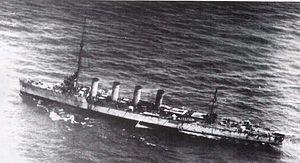SMS Novara (1913)

| |
| History | |
|---|---|
| File:Austria-Hungary-flag-1869-1918-naval-1786-1869-war.svgAustro-Hungarian Empire | |
| Name | Novara |
| Namesake | Battle of Novara1849 |
| Laid down | 1912 |
| General characteristics | |
| Class and type | Novara class cruiser |
| Displacement | list error: <br /> list (help) 3,380 tons (designed) 3,940 tons (full load) |
| Length | 130.64 m (428.6 ft) |
| Beam | 12.79 m (42.0 ft) |
| Draught | 5 m (16 ft) |
| Propulsion | list error: <br /> list (help) 16 x Yarrow boilers, 6 x Parsons steam turbines 25,130 shp |
| Speed | 27 knots (50 km/h) |
| Complement | 327 |
| Armament | list error: <br /> list (help) × 10 cm (3.9 in) guns 1 × 7 cm (2.8 in) gun 6 × 53.3 cm (21.0 in) torpedo tubes |
SMS Novara[1] was a Novara class light cruiser that served in the Austro-Hungarian Navy during World War I.[2]
Construction
In 1912, the cruiser Novara[2] was constructed for the Austro-Hungarian Navy, of the improved Spaun class design. As a smaller cruiser, the four-funnel Novara had a displacement of 3,500 tons, a length of 424 feet, beam 42 feet, and a complement of 318 crew. It carried armament of nine 3.9 inch and one 47mm landing gun, plus four 17.7 inch torpedoes. Its power/speed was 25000 hp/27 knots, and it had an armour belt of 2.5 inches and deck armour of 0.75 inches.
Service history
Novara took part in the attack on the Otranto Barrage on May 14/15, 1917, during which 14 Allied trawlers were sunk. Novara was slightly damaged when an Allied shell fractured one of its steam pipes, leading to a loss of power. She limped home.[3]
Novara was given to France following the end of World War I.[2] The ship was renamed Thionville and incorporated into the French fleet. The ship was scrapped in 1942.
See also
- See SMS Novara for ships of the same name.
Notes
- ^ In German language for ship names, "SMS" means "Seiner Majestät Schiff" (in English: "His Majesty's Ship"). See more at: Kaiserliche Marine.
- ^ a b c "SMS Novara, Austrian Postal History" (mail ship & postmark), Stamp Domain, 2001-09-30, StampDomain.com webpage: StampDom-Novara.
- ^ Kemp, Peter, The Otranto Barrage, in History of the First World War, BPC Publishing Ltd., Bristol, 1971, p.2269.
